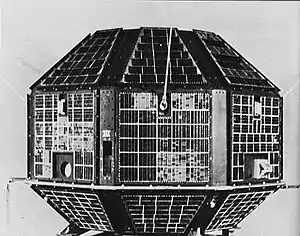| Names | Scatterometer Satellite-1 |
|---|---|
| Mission type | Earth observation |
| Operator | ISRO |
| COSPAR ID | 2016-059H |
| SATCAT no. | 41790 |
| Website | www |
| Mission duration | Planned: 5 years Achieved: 4 years, 5 months and 1 day |
| Spacecraft properties | |
| Bus | IMS-2 |
| Manufacturer | Indian Space Research Organisation |
| Launch mass | 371 kg (818 lb) |
| Power | 750 watts |
| Start of mission | |
| Launch date | 26 September 2016, 03:42 UTC |
| Rocket | Polar Satellite Launch Vehicle, PSLV-C35 |
| Launch site | Satish Dhawan Space Centre. First Launch Pad (FLP) |
| Contractor | Indian Space Research Organisation |
| Entered service | 15 December 2016 |
| End of mission | |
| Last contact | 28 February 2021 |
| Orbital parameters | |
| Reference system | Geocentric orbit |
| Regime | Low Earth orbit |
| Perigee altitude | 724 km (450 mi) |
| Apogee altitude | 741 km (460 mi) |
| Inclination | 98.1° |
| Period | 99.2 minutes |
| Instruments | |
| OceanSat Scatterometer-2 (OSCAT-2) | |
ScatSat-1 (Scatterometer Satellite-1) was a satellite providing weather forecasting, cyclone prediction, and tracking services to India. It has been developed by ISRO Satellite Centre, Bangalore whereas its payload was developed by Space Applications Centre, Ahmedabad.[1] The satellite carries a Ku-band scatterometer similar to the Oceansat-2 which became dysfunctional after its life span of four-and-a-half years. India was dependent on NASA's ISS-RapidScat for prediction of cyclone forecasting and weather prediction.[2] The data generated by this mini-satellite are used by National Aeronautics and Space Administration (NASA), European Organisation for the Exploitation of Meteorological Satellites (EUMETSAT) and National Oceanic and Atmospheric Administration (NOAA).
Instruments
The designated primary instrument of the satellite was a scatterometer (OSCAT) which was similar to the instrument launched with Oceansat-2. The satellite was built around a standard IMS-2 bus and the mass of the satellite was 371 kg (818 lb). The weight of the scatterometer was 110 kg (240 lb).[2] This satellite measured the wind speed and its direction over the ocean.
Development
Space Applications Centre (ASC) of ISRO was responsible for development of the instrument whereas ISRO Satellite Centre, Bangalore was responsible for the bus. ScatSat-1 was being built at 60% of the actual production cost and one-third of the actual predicted time.[3] It was built using leftover parts of other satellite missions.[4]
Launch
The satellite was launched on 26 September 2016, at 03:42 UTC, from the first launch pad (FLP) of Satish Dhawan Space Centre, Sriharikota (SHART) and launched by the PSLV-C35 launch vehicle the first multi-burn technology used by ISRO.[5] The microsatellites Alsat-1B, AlSat-2B and BlackSky Pathfinder-1, and nanosatellites AlSat-1N, NLS-19, PISat and Pratham were launched along with ScatSat-1.[6] It has been the longest Polar Satellite Launch Vehicle (PSLV) mission until date.
ScatSat-1 data
ScatSat-1 data are made available to the public through via FTP from the Meteorological and Oceanographic Satellite Data Archive Center, an e-portal maintained by Space Application Centre, Indian Space Research Organisation (ISRO).
Near-real time level two ocean wind vectors on a 25 / 50 km (16 / 31 mi) swath grid, based on the backscatter measurements of the ScatSat-1 are available through the e-portal of EUMETSAT.
End of mission
Data services of ScatSat-1 were discontinued after an irrecoverable TWTA instrument failure occurred on 28 February 2021.[7][8][9]
See also
References
- ↑ "Special Section: SCATSAT-1".
- 1 2 Nair, Avinash (27 May 2015). "To predict cyclone, ISRO to build advanced satellite". The Indian Express. Ahmedabad. Retrieved 8 February 2016.
- ↑ Singh, Tanaya (6 February 2016). "New ISRO Satellite to Predict Cyclones Being Built at 60% the Actual Cost, in One Third of the Time". thebetterindia.com. Retrieved 8 February 2016.
- ↑ "How ISRO is "recycling" to build a cost-effective satellite at 60% the cost and one-third the time". Firstpost. 5 February 2016. Retrieved 16 November 2017.
- ↑ "ScatSat-1". Retrieved 8 February 2016.
- ↑ "ScatSat-1 (Scatterometer Satellite-1)".
- ↑ Thomas, JV (13 April 2021). "ISRO Report on Current Missions and Future Plans Presented to CGMS-49 Working Group III session".
Stopped operations on Feb. 28, 2021 due to redundant chain malfunction. Detailed analysis is ongoing.
- ↑ Thapliyal, P. K. (23 April 2021). "ISRO highlights and issues in dataset and products Presented to CGMS-49 WG-II Session, Agenda 2".
Re-processing of Scatsat-1 data in v1.1.4 since June 20, 2019 completed (after Main chain TWTA failure) and data from Fairbanks station went into operational chain since August 2020. Anomaly observed in the on-board system of the redundant chain of Scatsat-1 since first week of March 2021. Analysis is being carried out.
- ↑ "OSI SAF ScatSat-1 OSCAT Wind Products". scatterometer.knmi.nl. Archived from the original on 10 April 2022. Retrieved 10 April 2022.
All ScatSat-1 services are discontinued following an irrecoverable instrument failure on 28 February 2021.

